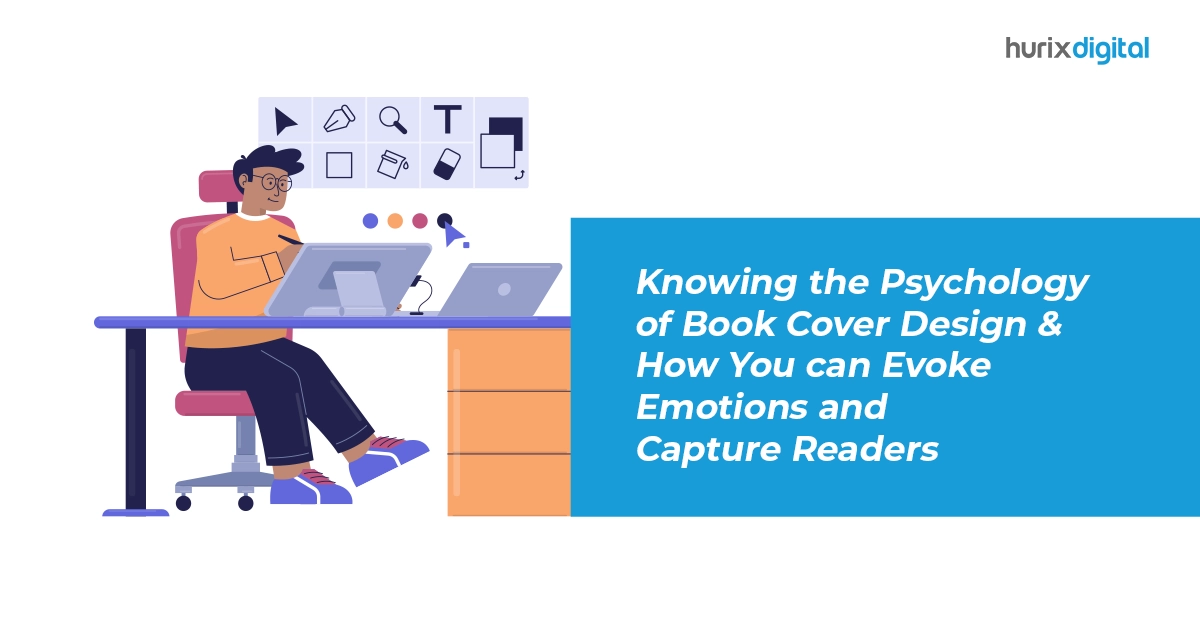
Knowing the Psychology of Book Cover Design & How You Can Evoke Emotions and Capture Readers
Standing in the quiet of a library, surrounded by towering shelves crammed with countless stories, you feel a familiar thrill of anticipation. Suddenly, a particular book catches your eye. The combination of color, illustration, and typography on its cover creates a distinct visual appeal, beckoning you to pull it from the shelf and dive in. This, in essence, is the power of an effective book cover design.
The adage “Don’t judge a book by its cover” might hold in social situations, but in publishing, appearances are everything. It is pivotal in the initial reader encounter, influencing choices on a subtle, psychological level. This article explores the intricate relationship between design and emotion, delving into how graphic elements – color, imagery, and typography – combine to create an appealing cover that resonates with potential readers.
Adhering to these principles enables authors and professional designers to craft covers that nail that critical first impression.
Table of Contents:
What Makes a Good Cover?
The human brain is a master of snap judgments, heavily influenced by visual cues. This is especially true when it comes to books. Whether browsing physical shelves or scrolling through online catalogs, our eyes gravitate toward the cover first.
While a fixed formula for success may not exist, crafting a polished and professional book cover design is paramount. This initial impression serves a dual purpose: establishing credibility and striking a chord with the target audience.
Marketing research emphasizes the power of first impressions. Studies show that consumers form an opinion about a product within 90 seconds, heavily influenced by its visual presentation. Consider a book cover as the book’s packaging. It needs to be visually arresting, offering a subtle suggestion of the story within and enticing readers.
Decoding How Book Cover Psychology Drives Engagement
This section discusses the key factors contributing to a successful book cover design that makes a book visually captivating and emotionally resonant. Book formatting services capitalize on these associations to produce the desired response from readers.
1. The Palette’s Power – Decoding Color
Color selection assumes a critical role in shaping reader perception and emotional response. The impact of color on a book cover is discussed below:
1. Color Psychology in Action
Colors have the inherent ability to forge specific associations within readers’ minds. A strategically chosen palette can establish the narrative’s tone, guiding readers toward a sense of lightheartedness, suspense, or something in between.
From a psychological perspective, color serves a multi-faceted purpose:
- Emotional Elicitation: Colors can evoke specific emotions within readers. A strategically chosen palette can establish the narrative’s tone.
- Visual Hierarchy: Color effectively separates elements on a cover by drawing attention to crucial details and establishing visual organization.
- Genre Signification: Color associations can subtly convey the genre of the book, offering potential readers a glimpse into the content without relying solely on text. For example, a romance novel might utilize soft pastel colors and imagery that spur a sense of intimacy. In contrast, a fantasy novel might feature bold colors, dramatic landscapes, and mythical creatures.
- Cultural Considerations: While color associations may vary across cultures and individuals, utilizing common palettes provides a strong foundation for reaching a broader audience. The key lies in identifying the emotions you wish to evoke in your target readership and selecting colors that effectively achieve that goal. It is recommended to limit the color palette on a book cover design to avoid visual overload. Typically, a maximum of three dominant colors and two accent colors create a balanced aesthetic.
Beyond temperature and visual cues, colors are ingrained with emotional and sensory connotations. A keen grasp of color psychology equips professional designers to create covers that resonate deeply, imbuing them with impact and meaning.
Also Read: How to Design Eye-Catching Book Covers for Print Publishing in 2024!
2. The Art of the Letter: Typography
Typography has the power to elevate or diminish a cover’s impact. Choosing the right font is a strategic decision influencing reader perception on two primary levels. Aligning the font style with the genre can create an immediate emotional connection with potential readers. Fonts can evoke specific genre expectations.
The second level prioritizes readability. No matter how visually striking a font may be, the message is lost if readers struggle to decipher it. Finding the perfect balance between creativity and legibility is crucial. Book formatting services ensure your manuscript is polished and professional, ready to captivate readers with a consistent layout, fonts, and spacing across all platforms.
For optimal impact, consider the following principles:
- Genre: The chosen font style should complement the genre. For instance, a horror novel might benefit from a bold, gothic typeface that evokes a sense of mystery and darkness, while a romance novel might call for elegant and flowing fonts that convey a sense of love and beauty.
- Readability: Strike a balance between creativity and readability. While the font should connect with the reader’s genre expectations, it must also be easy to read at a glance. Experiment with different fonts, sizes, and layouts to find the perfect combination that captures the book’s essence without sacrificing legibility.
- Minimalistic: While experimentation is encouraged, it is best to use a maximum of two fonts. A cluttered typographic landscape can overwhelm viewers and detract from the overall book cover design.
- Strategic Placement: The title should be the dominant element on the cover. If the author is not widely recognized, prioritize the title size over the subtitle and author name. Subtitles typically reside either directly beneath the title or nestled within its lines.
- Alignment: Maintain visual consistency by aligning the title, subtitle, and author’s name similarly, typically centered for optimal balance.
3. A Picture is Worth a Thousand Words- Imagery and Illustrations
Imagery is pivotal in book cover design, serving as a visual portal to the story within. A well-chosen book cover image can capture a reader’s attention and offer a glimpse into the book’s content, even before they click it open.
Book formatting services ensure your images are seamlessly integrated into the layout, maintaining optimal quality and proper placement for print and ebook formats.
1. Nonfiction
For nonfiction works, the book cover image should directly connect to the subject matter. A book on nature might showcase a breathtaking landscape, while a psychology book could utilize symbolic illustrations related to the mind or emotions. The goal is to represent the book’s core theme or idea visually.
2. Fiction
In fiction and poetry, the cover art offers greater creative license. While still reflecting the genre and central themes, the imagery can be more open to interpretation. A silhouette shrouded in mystery, an evocative scene, or even an abstract representation can pique the reader’s interest.
3. Finding Inspiration
Inspiration for appealing cover art can be gleaned from various sources – movie posters, photography, existing book covers, or paintings. The chosen style – photo-based, illustrated, minimalist, or abstract – should perfectly complement the mood and genre of the book. Do not shy away from established genre conventions; a masterful execution with artistic creativity can breathe new life into familiar themes.
4. Z-Pattern Layout for Maximum Impact
There is a powerful design principle that can significantly enhance a book cover’s appeal: the Z-pattern layout. The human eye naturally follows a Z-pattern when processing visual information, mirroring our reading pattern (left-to-right, top-to-bottom).
On a book cover, this translates to strategically placing text across the top and bottom, with the central image occupying the middle space, perhaps tilted slightly for added dynamism.
1. Isolation Effect on Impact
Patterning and visual preference also influence the central image selection. While symmetrical layouts can be aesthetically pleasing, they often lack the visual punch to stand out on a crowded bookshelf.
To achieve this, consider incorporating the “isolation effect” with bold contrasts in fonts and colors. This unexpected juxtaposition creates a visual spark that draws the reader’s eye and compels them to look closer. The central visual, whether an image or illustration, is then strategically placed at a slight angle within the remaining space.
5. Building Loyalty and Branding through Cover Design Consistency
The landscape of authorship has shifted. Success rarely blossoms from a single book. Particularly for self-published authors, a series offers a powerful path to building a loyal fanbase.
Authors who write multiple books cultivate a dedicated readership eagerly awaiting the next installment by crafting a compelling narrative arc with unforgettable characters. This is where visual traction and branding become crucial.
1. Recognition Through Familiarity
A consistent branding strategy allows readers to instantly recognize their favorite authors’ work, whether in a physical bookstore or while scrolling online. This familiarity breeds trust, making them more likely to pick up the next book in the series.
Psychologically, this recognition triggers positive emotions associated with enjoying the previous book, subconsciously linking those feelings to the new one.
2. The Power of Cohesion
Cohesive branding can be achieved through multiple elements: consistent typography, a signature color scheme, or recurring visual motifs. Maintaining a consistent design aesthetic makes it effortless for readers to identify your books and compel them to explore the vast literary landscape you have created.
Also Read: Making Math Books Accessible: Tips and Tricks for InDesign Designers
A 2025 survey by Ghostwriting Squad found that 79% of readers say book covers play a decisive role in whether they purchase a book. Additionally, professionally designed covers sell 2.5× more copies than DIY designs
The Bottom Line
Maximizing your book’s impact extends beyond personal creative vision. Understanding the psychology behind color, layout patterns, and visual preferences is essential for crafting a truly impactful design.
At Hurix Digital, we specialize in crafting book covers that ignite the reader’s imagination and overcome the boundaries of ordinary design. While artistic creativity is essential, our design team offers more.
They are strategic thinkers, well-versed in the psychology behind impactful book cover design. Leveraging our book formatting services translates to book covers that resonate deeply and leave a lasting impression.
Want to learn more? Contact us today!

Vice President – Content Transformation at HurixDigital, based in Chennai. With nearly 20 years in digital content, he leads large-scale transformation and accessibility initiatives. A frequent presenter (e.g., London Book Fair 2025), Gokulnath drives AI-powered publishing solutions and inclusive content strategies for global clients
 We’re live! Explore the all-new
We’re live! Explore the all-new 


